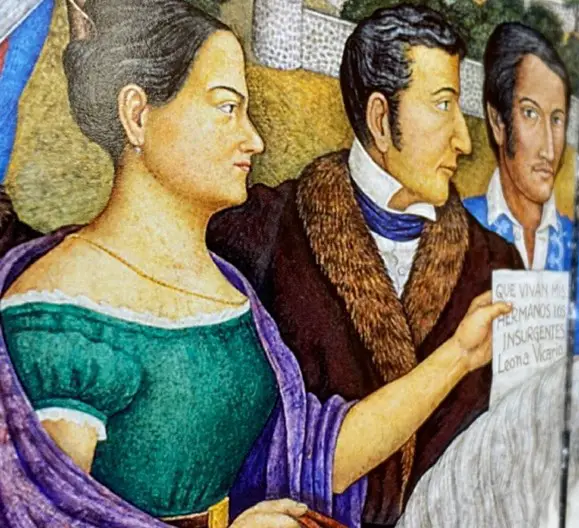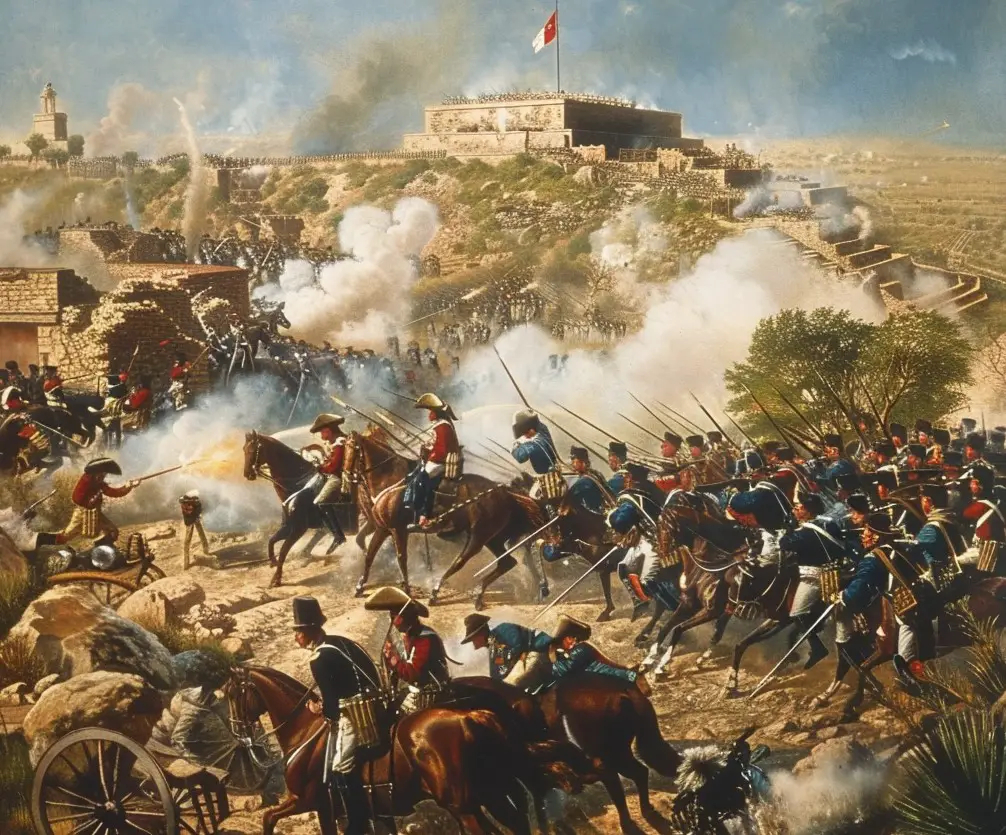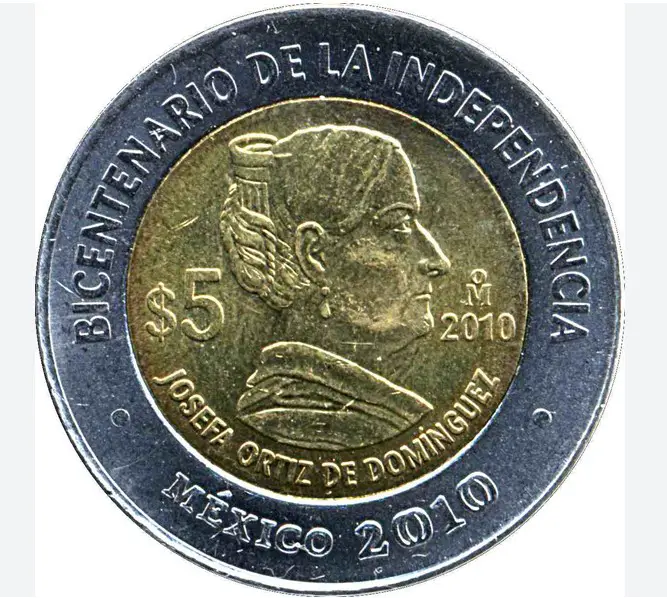Podcast: Play in new window | Download
Subscribe: Apple Podcasts | RSS
 The five-centavo coin of Mexico from the years 1942 to 1976 featured the familiar national emblem on the reverse side: the eagle on top of a cactus clutching a snake, which comes from the Aztec prophesy on where the wandering people should establish their capital city. On the front side of the coin – what coin collectors call the “obverse” – we see the profile of a woman. Many people, including some Mexicans, think this woman is La Malinche also known as Doña Marina, Cortez’ companion and translator profiled in Mexico Unexplained episode number twenty. https://mexicounexplained.com/mysterious-dona-marina-important-woman-mexican-history/ This woman on the five-centavo coin for many years – and on a commemorative five-peso coin for one year in 2010 – is María Josefa Ortiz de Domínguez also known as “La Corregidora.”
The five-centavo coin of Mexico from the years 1942 to 1976 featured the familiar national emblem on the reverse side: the eagle on top of a cactus clutching a snake, which comes from the Aztec prophesy on where the wandering people should establish their capital city. On the front side of the coin – what coin collectors call the “obverse” – we see the profile of a woman. Many people, including some Mexicans, think this woman is La Malinche also known as Doña Marina, Cortez’ companion and translator profiled in Mexico Unexplained episode number twenty. https://mexicounexplained.com/mysterious-dona-marina-important-woman-mexican-history/ This woman on the five-centavo coin for many years – and on a commemorative five-peso coin for one year in 2010 – is María Josefa Ortiz de Domínguez also known as “La Corregidora.”
In the annals of Mexican history, few female figures shine as brightly as María Josefa Ortiz de Domínguez. Her name evokes courage, sacrifice, and unwavering devotion to the cause of independence. Born into a colonial world fraught with inequality, oppression, and some confusion about its own future, Ortiz de Domínguez rose to prominence as a key player in the Mexican War of Independence, leaving an indelible mark on Mexico’s struggle against Spanish rule.
María Josefa Crescencia Ortiz Téllez–Girón came into the world on September 8, 1768, in the colonial city of Valladolid, now Morelia, Michoacán. Her early years were marked by tragedy, with the loss of her father, Captain Juan José Ortiz, in battle during her infancy and her mother dying a few months later. Left in the care of her sister, María Sotera Ortiz, young Josefa’s upbringing was anchored in resilience and fortitude.
Despite the challenges she faced, Ortiz de Domínguez received an education at the esteemed Colegio de las Vizcaínas, a prestigious girls’ school in Mexico City thanks to her sister’s efforts. Here, she was exposed to Enlightenment ideals and the burgeoning spirit of rebellion against colonial oppression. This period of intellectual awakening would shape her future path and ignite her passion for liberty and justice.
 In 1791, María Josefa Ortiz de Domínguez married Miguel Domínguez, a rising bureaucrat with connections to the colonial administration. Their union would prove pivotal in shaping her involvement in the independence movement. Miguel’s appointment as Corregidor – or magistrate – of Querétaro in 1802 brought the couple to the heart of colonial power, setting the stage for Josefa’s emergence as a revolutionary figure.
In 1791, María Josefa Ortiz de Domínguez married Miguel Domínguez, a rising bureaucrat with connections to the colonial administration. Their union would prove pivotal in shaping her involvement in the independence movement. Miguel’s appointment as Corregidor – or magistrate – of Querétaro in 1802 brought the couple to the heart of colonial power, setting the stage for Josefa’s emergence as a revolutionary figure.
As a wife and mother of 14 children, Ortiz de Domínguez navigated the complexities of domestic life while harboring a deep-seated sympathy for the marginalized and oppressed in colonial Mexican society. Her experiences as a wife and mother would inform her revolutionary fervor and strengthen her resolve to fight for a better future for her countrymen.
The social and political landscape of the later period of colonial Mexico was fraught with tension and discontent. For nearly three centuries her homeland had been ruled by an overseas monarch who delegated administrative duties to bureaucrats who were out of touch with the everyday reality of life in New Spain. There were vast differences in wealth and power among classes and groups. After some 12 generations of foreign rule, Mexico seemed likely to go the way of the United States and Haiti before it. As Ortiz de Domínguez observed the suffering of her fellow countrymen, she became increasingly disillusioned with the status quo and resolved to take action.
Attending clandestine meetings and literary circles, Ortiz de Domínguez found herself drawn to discussions of Enlightenment philosophy and revolutionary principles. It must be emphasized here that at the time many writings by Enlightenment authors were banned by the Catholic Church in New Spain and this met with full support of the colonial government. Inspired by the works of these banned Enlightenment thinkers and emboldened by the spirit of resistance sweeping across the Western Hemisphere, Ortiz de Domínguez began to envision a future for Mexico free from colonial tyranny and European entanglements.
Ortiz de Domínguez’s home in Querétaro became a focal point for revolutionary activity, hosting secret gatherings attended by prominent figures such as Miguel Hidalgo y Costilla and Ignacio Allende. Under the guise of literary discussions, plans for rebellion were meticulously laid out, with Ortiz de Domínguez playing a central role in organizing and coordinating the nascent insurgency.
 When Napoleon overthrew of King Ferdinand VII of Spain in 1808 during the Peninsular War, this change of power provided the catalyst for rebellion, and the prospect of independence grew increasingly tantalizing for forward thinking people of New Spain. The stage was set for a daring uprising against Spanish colonial rule, with Ortiz de Domínguez at the forefront of this revolutionary movement but tragically, the hopes of the revolutionaries were dashed by betrayal. A major uprising against the Spanish authorities was planned for December 8, 1810 but on September 13, 1810, a supporter revealed the conspiracy to colonial authorities, jeopardizing the carefully laid plans for rebellion. Despite her husband’s attempts to shield her from harm, Ortiz de Domínguez found herself imprisoned, separated from her family and comrades. Her confinement did little to dampen her resolve, however. Through acts of cunning and courage, she managed to communicate with fellow insurgents, providing crucial intelligence and enabling many to evade capture. Her defiance in the face of adversity earned her the admiration of her peers and solidified her reputation as a symbol of resistance.
When Napoleon overthrew of King Ferdinand VII of Spain in 1808 during the Peninsular War, this change of power provided the catalyst for rebellion, and the prospect of independence grew increasingly tantalizing for forward thinking people of New Spain. The stage was set for a daring uprising against Spanish colonial rule, with Ortiz de Domínguez at the forefront of this revolutionary movement but tragically, the hopes of the revolutionaries were dashed by betrayal. A major uprising against the Spanish authorities was planned for December 8, 1810 but on September 13, 1810, a supporter revealed the conspiracy to colonial authorities, jeopardizing the carefully laid plans for rebellion. Despite her husband’s attempts to shield her from harm, Ortiz de Domínguez found herself imprisoned, separated from her family and comrades. Her confinement did little to dampen her resolve, however. Through acts of cunning and courage, she managed to communicate with fellow insurgents, providing crucial intelligence and enabling many to evade capture. Her defiance in the face of adversity earned her the admiration of her peers and solidified her reputation as a symbol of resistance.
On the fateful morning of September 16, 1810, Miguel Hidalgo y Costilla, a Catholic priest, delivered his iconic Cry of Dolores, condemning “bad government” and signaling the beginning of the Mexican War of Independence. Inspired by the ideals of liberty and equality espoused by figures like Ortiz de Domínguez, thousands rallied to the cause, igniting a nationwide uprising against Spanish colonial rule. Though physically confined, Ortiz de Domínguez’s spirit soared alongside her compatriots as they embarked on their quest for freedom. Her unwavering commitment to the cause of independence served as a beacon of hope for those fighting on the front lines of the revolution. Eventually, Josefa’s husband also faced persecution and imprisonment at the hands of colonial authorities. Josefa was transferred to the Monastery of Santa Clara in Queretaro before being sent to Mexico City to stand trial. After being found guilty, she was sent to two different places for confinement. Both were within the convents of religious orders. Spanish colonial authorities, still holding on to their crumbling empire int he New World, let her go in 1817, after having her sign a document pledging to cease all rebellious activities against the government. Despite enduring years of hardship and isolation, she remained steadfast in her convictions, and secretly refused to renounce her allegiance to the cause of independence.
Following the conclusion of the war of independence in 1822, Mexican Emperor Agustín de Iturbide extended an offer to Ortiz de Domínguez: the prestigious role of lady-in-waiting for his wife, Ana María de Huarte y Muñiz. https://mexicounexplained.com/ana-maria-forgotten-empress-mexico/. However, Ortiz de Domínguez, ever steadfast in her principles, declined the honor. For her, the establishment of a Mexican Empire, rather than a Republic, contradicted the very ideals she had fervently championed during the revolutionary period. Her refusal to accept such a position underscored her unwavering commitment to the cause of democracy and freedom.
In 1823, Ortiz de Domínguez was bestowed with the title of “woman of honor” by Empress Ana María. Yet, in a display of integrity, she rejected this tribute as well, unwilling to compromise her principles for personal recognition or gain. Throughout her life, Ortiz de Domínguez remained resolute in her belief that her actions were not motivated by the pursuit of rewards or accolades but by a profound sense of duty and patriotism.
As the years passed, Ortiz de Domínguez continued to be actively engaged in radical political circles, advocating for social justice and reform. Despite offers of recognition and reward, she steadfastly maintained her stance, reaffirming her commitment to the ideals of liberty and equality.
Tragically, Ortiz de Domínguez’s remarkable journey came to an end On March 2, 1829, in Mexico City. She was just 55 years old. Initially laid to rest in the convent of Santa Catalina de Sena, her remains were later relocated to Querétaro, a testament to her enduring legacy in the hearts and minds of the Mexican people. The government of Querétaro posthumously honored her with the title of “Benemérita del Estado,” which loosely translates to “Honorable Person of the State.” This title was to recognize her tireless and invaluable contributions to the cause of independence and nation-building. And a century after the first cries for Mexican independence, Mexico honored Josefa by putting her on a postage stamp. Stamp collectors know that along with Leona Vicario, she became the first woman ever to be featured on Mexican stamps. The coin honor would occur 32 years later.
 María Josefa Ortiz de Domínguez’s remarkable journey from colonial subject to revolutionary icon embodies the spirit of resilience and defiance that defined the struggle for Mexican independence. Her unwavering commitment to the cause of liberty and justice continues to inspire generations of Mexicans, serving as a testament to the power of individual courage in the face of opposition and government oppression. Some believe though, that her work is not yet finished, as the nation of Mexico continues to struggle with issues of equality and good government.
María Josefa Ortiz de Domínguez’s remarkable journey from colonial subject to revolutionary icon embodies the spirit of resilience and defiance that defined the struggle for Mexican independence. Her unwavering commitment to the cause of liberty and justice continues to inspire generations of Mexicans, serving as a testament to the power of individual courage in the face of opposition and government oppression. Some believe though, that her work is not yet finished, as the nation of Mexico continues to struggle with issues of equality and good government.
REFERENCES
Martínez Álvarez, José Antonio. Mujeres por la Independencia de México. Independently published, 2021. (in Spanish) We are Amazon affiliates. Buy the book on Amazon here: https://amzn.to/3TCaVC7
